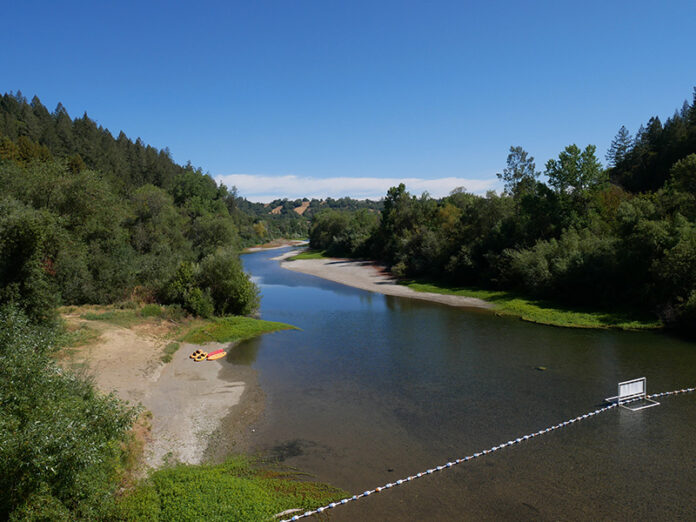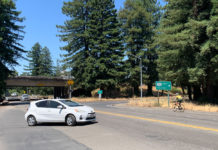
The deadline for the roughly 1,500 Upper Russian River watershed water rights holders to join a novel water sharing program organized by local stakeholders and approved by the California State Water Board is June 20.
After that date, local water rights holders will no longer be able to participate in the water sharing program, which guarantees participants uninterrupted access to at least a portion of the water they usually get from the Upper Russian River during the summer months if they conserve a minimum of 20 percent or more versus their prior usage.
“Participants are guaranteed to not be fully curtailed,” says Terry Crawley, Healdsburg’s utility manager. Rights holders who do not participate could completely lose their water rights during the summer months, versus losing only a portion if they do participate.
While the water sharing program does not impact residential water users directly, it does impact the local economy. “If you lose your vines, that has a long lasting effect on the total economy of Sonoma and Mendocino counties,” says Crawley. “It depends on who participates in the program, but we’re suspecting that our conservation requirement this summer will be reduced by 10 to 15%. It is still a drought year and there is still a need for conservation, but it won’t be as severe as it would have been without the program,” he says.
In summer months, the City of Healdsburg uses 70 to 78 million gallons of water. That usage contracts to less than 40 million gallons per month in the winter. But last summer, the city led the state in water reductions by getting residents to cut down on outdoor lawn watering, and by asking hotels to reduce their consumption by 40%. The Healdsburg Golf Club at Tayman Park has its own groundwater well and does not rely on city water for irrigation.
California first began recording water rights in 1914. Healdsburg has three water rights on the Upper Russian River, a water right on Dry Creek and a backup water supply with the Sonoma Water Agency. But none are considered top priority rights. Water rights registered with the state before 1914 are the most senior. The California State Water Board curtails water rights based on the date recorded, so the oldest water rights are the last to get cut off.
There are currently only 52 entities in the Russian River watershed with pre-1914 water rights. They include Beringer Wine Estates, the City of Santa Rosa, Gallo Vineyards, Sonoma County Regional Parks, private companies and individuals. A complete list of local water rights holders is available on the last tab of the Exhibit B Calculations spreadsheet on the State Water Board’s website.
The more senior water rights holders who participate, the more potential the water sharing program has to defer curtailments. But so far only 13 water rights holders, including the City of Cloverdale, which has a pre-1914 water right, have agreed to participate. Healdsburg City Council decided to participate and the city will file its application before the June 20th deadline. Other steering committee members are expected to participate as well. The State Water Board will announce the total number of participants before July 1.
“Last year was the first time since 2014 that the State Water Board issued curtailment orders to all rights holders in the Upper Russian River,” says Sam Boland-Brien, supervising water resource control engineer at the California State Water Resources Control Board, which has no other options but to cut water rights holders off completely when levels get too low.
Unlike the Federal Reserve Board, which can incrementally adjust interest rates, current water laws provide no framework for incrementally regulating water rights. It’s an all or nothing scenario, which is why local stakeholders organized the water sharing program as an alternative to the state’s more dire water management ultimatum.
To manage the escalating threat of pronounced water shortages as the Western United States gets hotter and drier from fossil fuel emissions, creating a greenhouse effect that traps heat in our atmosphere, the cities of Cloverdale, Healdsburg and Ukiah, several Native American tribes, local water agencies, farm bureaus, EJ Gallo, Jackson Family Wines and others formed a steering committee to find a local solution to a global problem.
Longtime environmental steward Jackson Family Wines—the ninth largest wine producer in the U.S.—has pre-1914 riparian and appropriative water rights and will participate in the water sharing program. Jackson was already voluntarily providing water for salmonids through a safe harbor agreement with the National Marine Fisheries and the California Dept. of Fish and Game, which the water sharing program recognizes and accepts, according to Carolyn Wasem, senior vice president of government relations at Jackson Family Wines. But it remains to be seen how many other committee members will enroll and participate.
“This was not something that came from above. It’s not from the regulators,” says Elizabeth Salomone, general manager at the Mendocino County Russian River Flood Control, which manages the water resources of the upper Russian River in Mendocino County. “The legal agreement, the program and a lot of the outreach was driven by the steering committee here regionally. It’s a group effort, but by no means is this a State Water Board designed program. That’s what makes it so special and unique,” says Salomone.
On April 21, 2021, Gov. Gavin Newsom declared a drought emergency in Sonoma and Mendocino counties due to dry conditions in the Russian River watershed, which is home to 360,000 people and provides water for municipal and private wells, agriculture, wineries and recreation. The Upper Russian River stretches from the Potter Valley north of Lake Mendocino all the way down to Healdsburg.
The Russian River watershed is the area that deflects and channels rainwater into the Russian River, like the surrounding hills and mountains that straddle the Russian River, as well as the mountains alongside the Eel River, which feeds into the Russian River at the Lake Mendocino Reservoir in Ukiah by means of a man made diversion tunnel built in 1908.
Eric Schwartzman is editor of the Sonoma Wine Tasting Blog.








